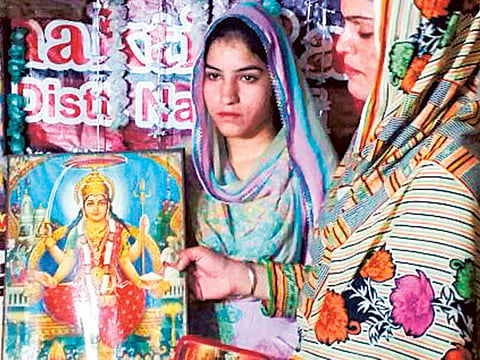Hindus live in harmony and adapt to new lifestyles
There are many Hindu temples in Lahore but only one is functioning

Lahore
Asha Devi, 30, remembers when she along with her husband went for their honeymoon in the tourist resort of Murree two years ago and had to go through a lot of embarrassment when police at a check post demand proof of their marriage. They tried to convince the officers and finally after a long argument were allowed to go.
“They did not believe in our national identity cards. I showed them mangal sutra [the necklace worn by married Hindu women]. One policeman then recognised its importance remembering some scenes from an Indian film. They then allowed us to go,” Asha told this scribe.
Now Hindus will not have to face embarrassing situations as the recently passed Hindu Marriage Act in the National Assembly essentially legalises their marriages.
Earlier, it was not so; they did not have marriage certificates which were registered with the state. Now each pundit who performs the marriage ceremony puts the certificate details in the register, one copy of which goes to the state like the marriages of Muslims and Christians.
According to the Pakistan Bureau of Statistics’ population distribution by 1998 census, there are 2,111,271 or 1.6 per cent Hindus living in Pakistan. The life of the Hindus in urban areas is completely different from those that live in rural areas, especially Sindh.
There they have villages whose entire population is Hindu. There are about 300 Hindu families living in Lahore.
Except for about 130 Balmiki Hindu families the rest are all well-off people living in uptown areas. Balmiki mostly live in the old Walled City and an area called Neela Gumbad. They mostly do low salaried odd jobs like sanitary work.
There are many Hindu temples in the city but only one is functional. Krishna Mandir on Ravi Road comes alive every Tuesday when there is a weekly special puja (prayer service). Krishna Mandir is a three-storey building that does not resemble the traditional temple. The white marble building looks like a house and does not have the traditional dome. However, once inside you get the feel of traditional temples.
Two floors house the temple, where prayers are held, while the third serves as the residence for the pundit and his family. Interestingly, the temple carries the images and statues of the main Hindu deities. It is shared by Hindus of all denominations.
Three staff members of the Evacuee Trust Property Board (ETPB) are always present to help the pundit and visitors from morning till evening. The number of visitors is not high. The congregation gathers only on Tuesdays or on special occasions like Holi, Diwali, Janmashtami and other religious festivals.
Pundit Kanshi Ram, 35, hailing from Battagram district of Khyber Pakhtunkhwa province has been serving as priest at Krishna Temple for 18 years.
ETPB, to which the temple is affiliated, spends around Rs50,000 (Dh1,753) on all arrangements from providing prashad (sweets) to security for Hindu festivals.
“Our congregation members are from all sections of society. Some are businessmen while some are doctors or work in different government departments. One Hindu member is working as sub-divisional officer of Wapda (power utility) in the Karim Park area. I come from Battagram where around 100 Hindu families live in peace and harmony,” Kanshi said.
He has two children. His son Shivam Kumar is eight years old and a student in second grade. He studies in the private Moon Public School in the Ravi Road area. “My daughter Rasna Devi is only a year old and I dream of a good destiny for her,” Kanshi said
Hindu yatrees (pilgrims) from India visit Pakistan twice annually.
They always visit this temple, an old building dating back to the 1930s. A special two hour prayer is arranged for them before they leave for the Katas Raj temple which is over 200 kilometres upcountry.
“Hindus used to perform last rites in the traditional way. They did that near River Ravi. ETPB made Shamshanghat about a year ago. Now the last rites of Hindus and Sikhs are performed there. The bodies are cremated there. The rumours that Hindus had started burying their loved ones upon death are not correct. We have continued our tradition of cremating bodies.
Shezadi Meera lives in a village near Narowal outside Lahore. Like all young people she dreams of making it big someday. She and her cousin Kamlesh are both law stud-ents. “We chose this profession because we want to help our community. We do not face any problem, but there are many issues. We would like to fight the legal battles of our community,” they said.
Sign up for the Daily Briefing
Get the latest news and updates straight to your inbox



